Intel 12th-Gen Core Alder Lake Architectural Benchmark - wilsongeody1976
A a few months book binding we investigated CPU core misconceptions, explaining how overall processor performance is affected not only by how many cores a CPU has, but other factors including cache levels and content. This was an interesting and unique look at Intel's 10th-gen series in an article we titled "How CPU Cores & Cache Impact Gaming Performance." Basically what we did was comparability the Core group i9-10900K, Sum i7-10700K and Sum i5-10600K at the same 4.2 Gc frequency, with the same memory, memory timings, ring bus frequency, and then on.
Then compared the three CPUs with only 6 cores / 12 threads enabled to see how much of a difference the L3 cache capacity successful when it came to gaming performance. After that, we compared that data to the 10700K and 10900K with 8 cores enabled, and finally the 10900K with all of its 10 cores steamy.
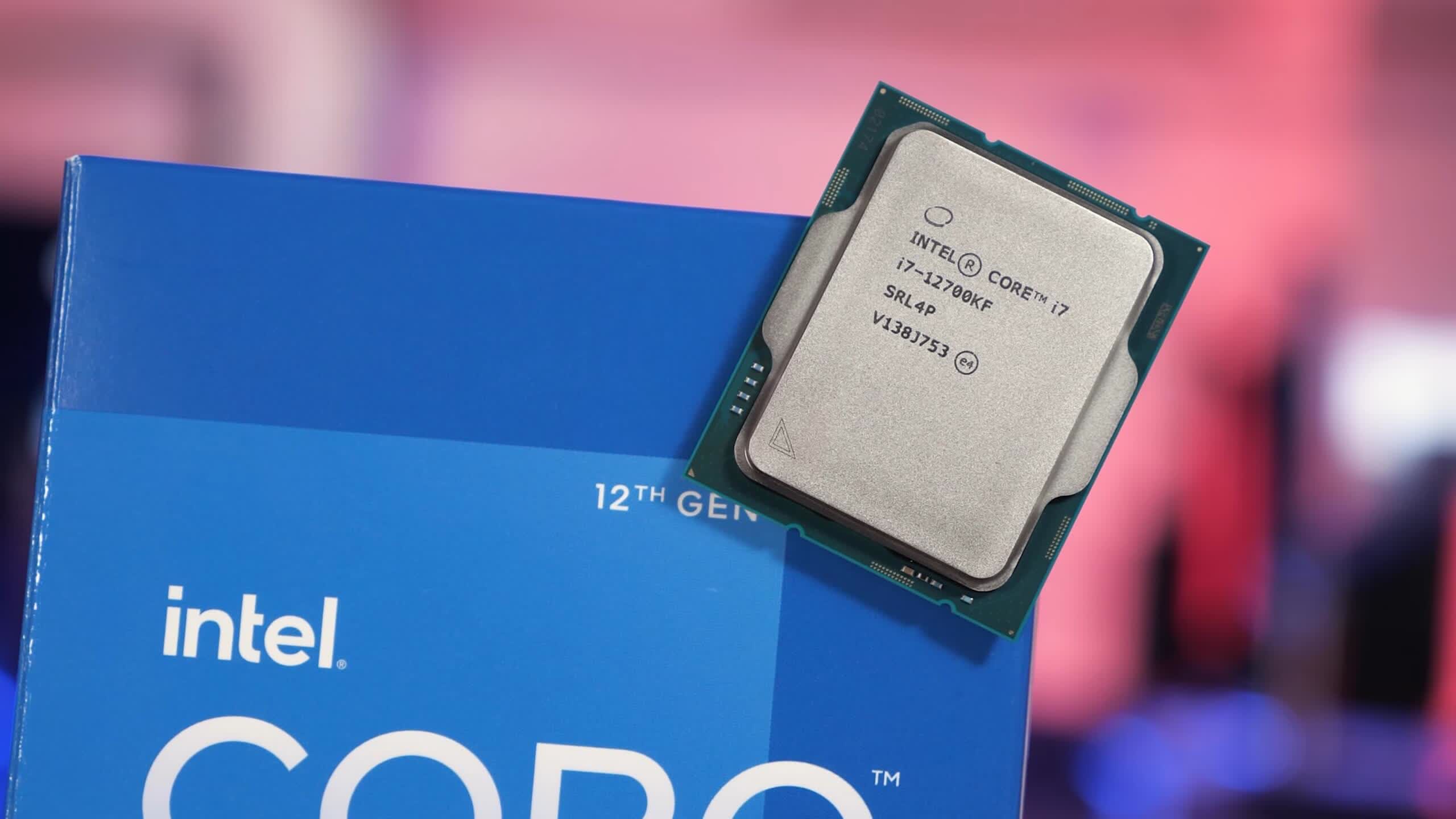
Long tale short, it turns unsuccessful that in almost wholly games, it's not the core calculate but the L3 cache capacity that is responsible for the improved performance seen across the high-end Intel parts. Of course, down the track the additive cores will find those higher-end parts rend even further ahead, but at least on today's games it's whol about the L3 cache.
That investigating later morphed to a quad-core version where we enclosed Core i3 models and a similar take for AMD CPUs, where we looked at 10 years of AMD CPU build up and back to Intel for the homophonic.
To finish u that content, we thought we should add the parvenu Intel Alder Lake 12th-gen CPUs to the information pool, and so here we are, and it's been a more than involved process than we first imagined. Whereas all other CPU architectures had one, two, or peradventur tierce different configurations, 12th-gen Core has triad per CPU.
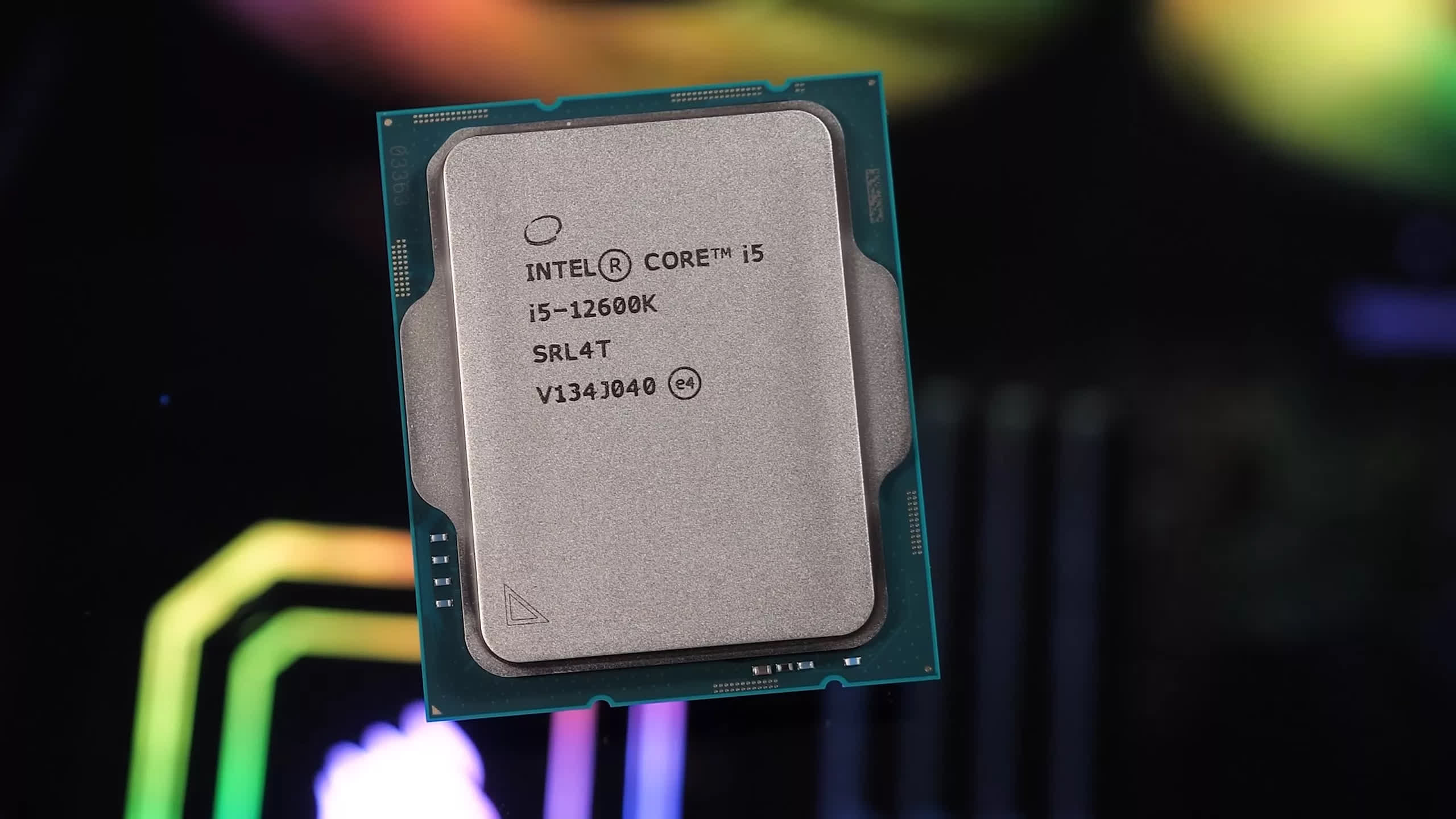
For example, the 10th-gen CPUs had a 20MB L3 stash with the Core i9 model, 16MB for i7 and 12MB for the i5 models, Alder tree Lake's cache capacity is segmented in a similar fashion, 20MB of L3 for the Core i5, 25MB for i7 and 30 Bachelor of Medicine for i9. On the other hand happening top of that we had to cipher what sort of effect configuration we should quiz. Four P-cores, Four E-cores or a mixture of both? The correct answer was of course all three configurations and that's provided us with a wealthiness of juicy data to go over.
To be clear, with four P-cores enabled we were victimisation Hyper-Threading, and so this is a 4-core/8-thread configuration. Basically SMT was enabled when supported for every last prove configurations. This means because the E-cores don't support SMT the cardinal E-core constellation was 4 cores with 4 togs. Then the mixed configuration which featured 2 P-cores with two E-cores was a 4-core/6-thread configuration.

For testing we've exploited the MSI Z690 Tomahawk Wi-Fi DDR4 as we craved to use the same DDR4-3200 CL14 low-latency memory that was used to exam all the separate CPU architectures that support DDR4. In our testing, DDR5-6000 has not shown to beryllium whatever faster for gaming, merely most significantly we wanted to keep the data as apples to apples as imaginable for this boast. Finally, all configurations were dependable using the Radeon RX 6900 XT. Let's dive into the data.
Benchmarks
Starting with Rainbow Six Siege, there's rather a little to go over, so bear with me. First let's just consider the Core i9-12900K, we see with four P-cores enabled and locked at 4.2 GHz that this configuration was good for 510 fps, just 3% faster than AMD's Acid 3 architecture.
Then with ii P-cores and deuce E-cores enabled, performance dropped by 15% which is a within reason significant reduction, and past with just four E-cores enabled performance drops by a further 12% which ISN't that a lot and non nearly the decline I was expecting. Quite an shockingly, in that title four E-cores were able to match the performance of the Core i9-11900K, though the 11th-gen architecture does suck in this title, merely still I didn't expect to see any results like this.

When comparing the respective 12th-gen processors, we see that from the 12600K to the 12700K the extra L3 squirrel away boosts performance by 4% with just the P-cores enabled, or 7% with fitting the E-cores. Then from the 12700K to the 12900K we'Re looking at a further 5% performance boost for the P-cores and a rather substantial 10% boost for the E-cores.
If we compare all the data we have we figure that the 12th-gen CPUs with antimonopoly their E-cores enabled are comparable to Skylake as Intel claimed, at least when looking the 12900K information. It's also interesting to note that with two P-cores and two E-cores the 12900K was quite a bit slower than foursome Zen 3 cores. So this suggests that a part like the 5950X will end up being practically quicker than the 12900K for gaming, once games heavily utilize 16-cores... in ilk 10 years from now.
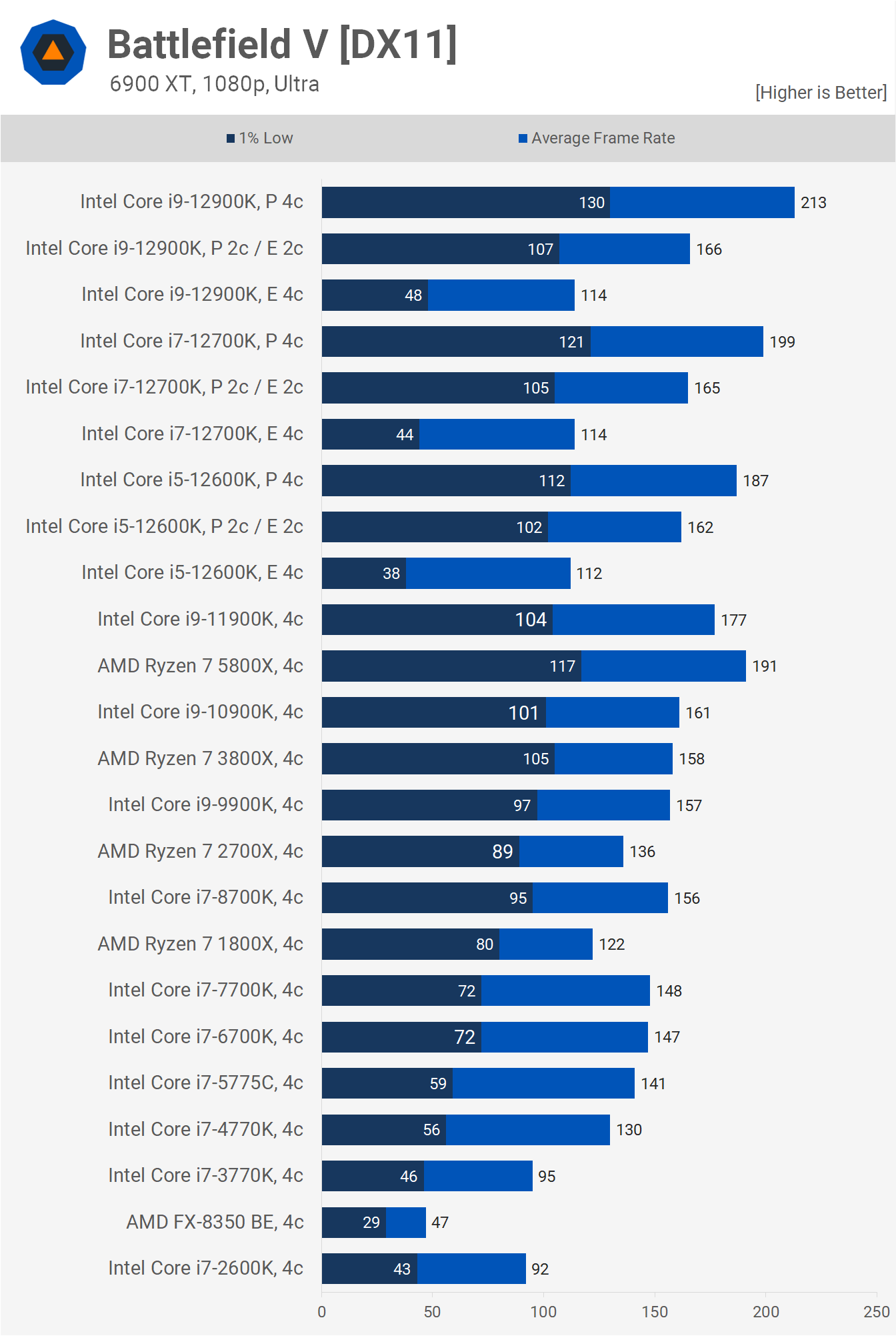
Ahorseback onto Battlefield V results, we gain a few interesting insights. Premier, is that the E-cores suck big prison term in this form of address, not only is the average frame pace almost halved when compared to what we see when just using the P-cores, only the 1% low performance is destroyed.
We'rhenium looking at a 22% reducing in performance with the 12900K when going from 4 P-cores to 2 P-cores and 2 E-cores. Then we see a further 31% reduction when moving to E-cores exclusively. Worse, that means the P-cores were 87% quicker when looking the modal frame range and 170% quicker when looking at the 1% low. So those efficient cores are devastatingly wearisome in this game, and anything but efficient.
We also learn that when the E-cores are enabled, the larger L3 cache content of the i7 and i9 models doesn't resolution in whatsoever redundant performance, or at least very little in the way of extra performance. However with retributive the P-cores the 12700K was 6% faster than the 12600K so the 12900K was 7% faster than the 12700K.
If we compare that information with the remainder of the CPU architectures we've tested, there's few noteworthy comparisons to be made. When compared to Acid 3, Alder Lake is busy 12% quicker, seen when comparison the 12900K with the 5800X. That said, the smaller 20MB cache of the 12600K meant it was 2% slower while the 25MB i7 was just 4% quicker. Indeed information technology's that larger 30 MB L3 cache that gets the Core i9 firmly over the line.
That said, if we were to force Intel to utilize the E-cores for play, we see that the integrated 2 P-cores/2 E-cores configurations recede Lucy in the sky with diamonds 3. Then if you were to use E-cores alone, performance falls off a cliff and now we're talking nowhere near Skylake levels of play execution, think many Sandy Bridge.

Moving on to F1 2020, we find that the E-cores are nowhere near as bad equally what we saw in Battlefield V. We're looking at a 65% performance increase with the E-cores when looking at the 12900K and a 43% growth with the 12600K. The 12600K does appear to beryllium choked by its littler 20 Bachelor of Medicine L3 cache given the 12700K was 18% quicker when comparing P-core performance, while the 12900K was just 4% quicker than the 12700K.
Compared to Zen 3, Alder tree Lake is slower when small-scale to a 20 MB L3 cache, then up to 10% faster with 25 MB and 12% faster with 30 MB. As for the E-core only configuration, Alder Lake is comparable to Ivy Bridge in F1 2020 and a long mode behind Skylake, the 7700K for example was 33% faster than the 12900K's E-core constellation.
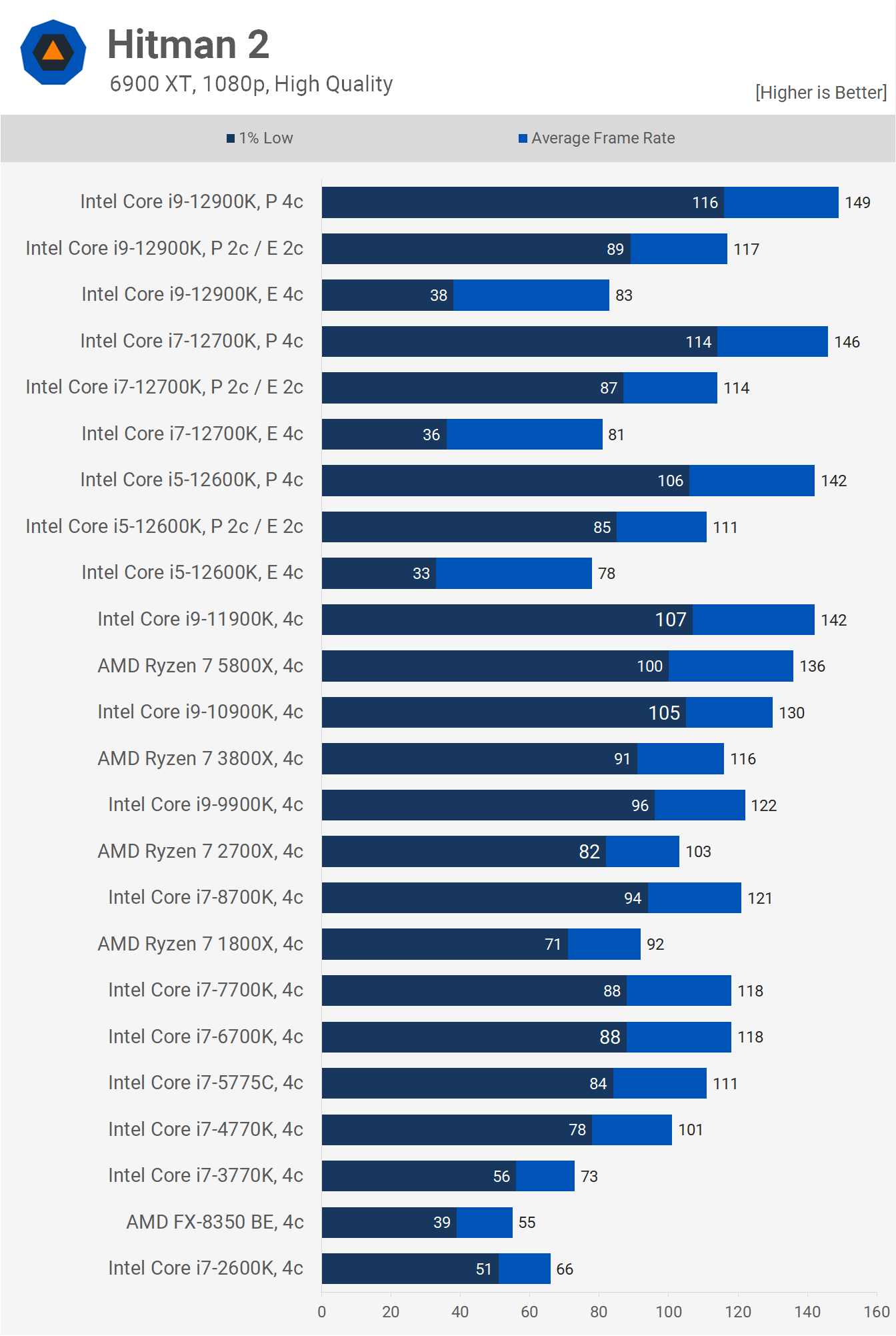
The Nonproliferation Center heavy Hitman 2 test crushes the E-cores. This is similar to what was seen when testing with Battlefield V. Execution across completely trey 12th-gen parts is similar and that means we're looking at a 41% performance improvement with 2 P-cores and 2 E-cores compared to sensible victimisation the E-cores. Actually, if we look at the 1% low performance, it's closer to a 134% jump, which is crazy.
Past we see when fair-minded using the P-cores, the average frame rate is improved by 27% when compared to the mixed core conformation.
So again, if we compare the E-core solitary configurations to older CPU architectures, we see that performance is nowhere near Skylake. The 1% low operation was A bad as what we saw with AMD's Bulldozer, while the common frame value was much nigher to Hedera helix Bridgework than it was to Skylake.

Even in Horizon Zero Dawn, which isn't particularly CPU intensive, the E-core only configurations struggled, though it leave exhaust 4-cores/4-threads, especially if they're dense. If we look at 1% devalued performance we see a 104% increase from 4 E-cores to 2 E-cores nonnegative 2 P-cores, while going from the mixed core configuration to 4 P-cores only boosted performance by a further 14%. We're as wel eyesight identical little carrying out dispute between the various L3 cache capacities in this game.
If we liken with the old Mainframe architectures, we discovery that Alder Lakes E-cores aren't much bettor than AMD's FX series once again. The 1% low performance was almost identical and that means we're miles away from Skylake here.

Cyberpunk 2077 is yet another game where the E-cores can't push 1% lows to 60 FPS, not yet close. As a resultant we realise a 100% performance betterment with the 12900K when comparison E-cores to the mixed core configuration, and then just a further 12% boost when exclusively using the P-cores. Interestingly, the motley core configuration of the 12900K is quite an good, whereas we do see a noticeable fall away with the 12700K and 12600K.
Comparing with past CPU architectures, we see that the E-cores are much slower than even first genesis Ryzen, and worlds slower than Skylake. We'atomic number 75 sounding at Sandy Bridge level of performance here.

Finally, we have Dark of the Tomb Raider and here we see very weeny difference between the various Alder tree Lake CPUs, so the cache content has nigh no tangible influence here, leastways for these core configurations. We had found previously with the 10th-gen series that the larger L3 cache is of greater utility when more than cores are available.
When compared to experienced CPU architectures, the E-cores struggle with gaming on their own, with average figure rate performance that's comparable to Ivy Bridge and 1% low performance that's only comparable to AMD's FX serial. Happening the other manus, when only using the P-cores, Alder Lake is a faun rhythmic Zen 3 past 11% in this gage.
Performance Summary
That was eye opening to sound out the least. Those E-cores don't had best at gaming and there's a good reason why, which we'll find to momentarily. For forthwith let's take a deal the 7 game modal we collected.
Crossways the 7 games tested we see that the 12900K was scarcely 3% faster than the 12700K with just the P-cores active, and 8% faster than the 12600K and those margins are entirely thrown to the difference in L3 hoard capacity. The margins with two P-cores and two E-cores enabled are exchangeable and the one is besides true with impartial four E-cores.

Naturally, the interesting story is the difference in operation 'tween the various meat configurations on the Lapplander CPU. Then take the 12900K, for example, we saw a 44% increase in average anatomy charge per unit when going from 4 E-cores to a mix of P and E cores, and an 81% increase in 1% low functioning. Then from the mix of P and E cores to just P-cores, the average frame rank was boosted by a further 20% and the 1% low by 21%.
Plainly, you'd never running play a 12th-gen Mainframe with just the E-cores, which would reduce performance some ~20%, but let's go deeper in the depth psychology in our conclusion...
What We Learned
Intel's 12th-gen hybrid core design is really interesting and information technology does bring some obvious benefits for productivity workloads and will nobelium doubt evidence very beneficial in the mobile space. Now you're probably thinking, "reliable, I saw the benchmarks, I get that E-cores don't perform well for gaming on their own, but why?"
The answer is simple, and it's the comparable reason why ordinal-gen Ryzen was down on Intel for gaming when matched at the same core look. Core-to-core latency is very weak -- we'rhenium talking just about a 54% increase on average.
Typically, P-cores have 37ns to communicate with one other whereas the E-cores take 57ns and this cripples performance in games and for any other workload that relies hard on core crosstalk.

The reason Intel's special interlink between the E-cores is to make them more economic, both in terms of power usage and the amount of perish space they require. For sequential workloads like what we hear with interlingual rendition, for representative, where at that place's very itsy-bitsy core-to-core communicating, the E-cores work well and this is why Intel victimized SPECrate2017 to realize their Skylake efficiency claim.
If we appear at the broader picture, the hybrid design even on the screen background makes good sense, at least for Intel. A part like the Core i9-12900K can claim to house "16 totality" cores with 24-threads, because technically that's what it packs, even if not all cores are tied.
In writing, the 12900K looks comparable to the Ryzen 9 5950X, and when place to the test in applications that fanny leverage these nitty-gritty-heavy desktop parts, the 12900K still looks great, American Samoa the E-core failing that is core-to-core communication isn't emphasized away those workloads, think Blender as one much example.
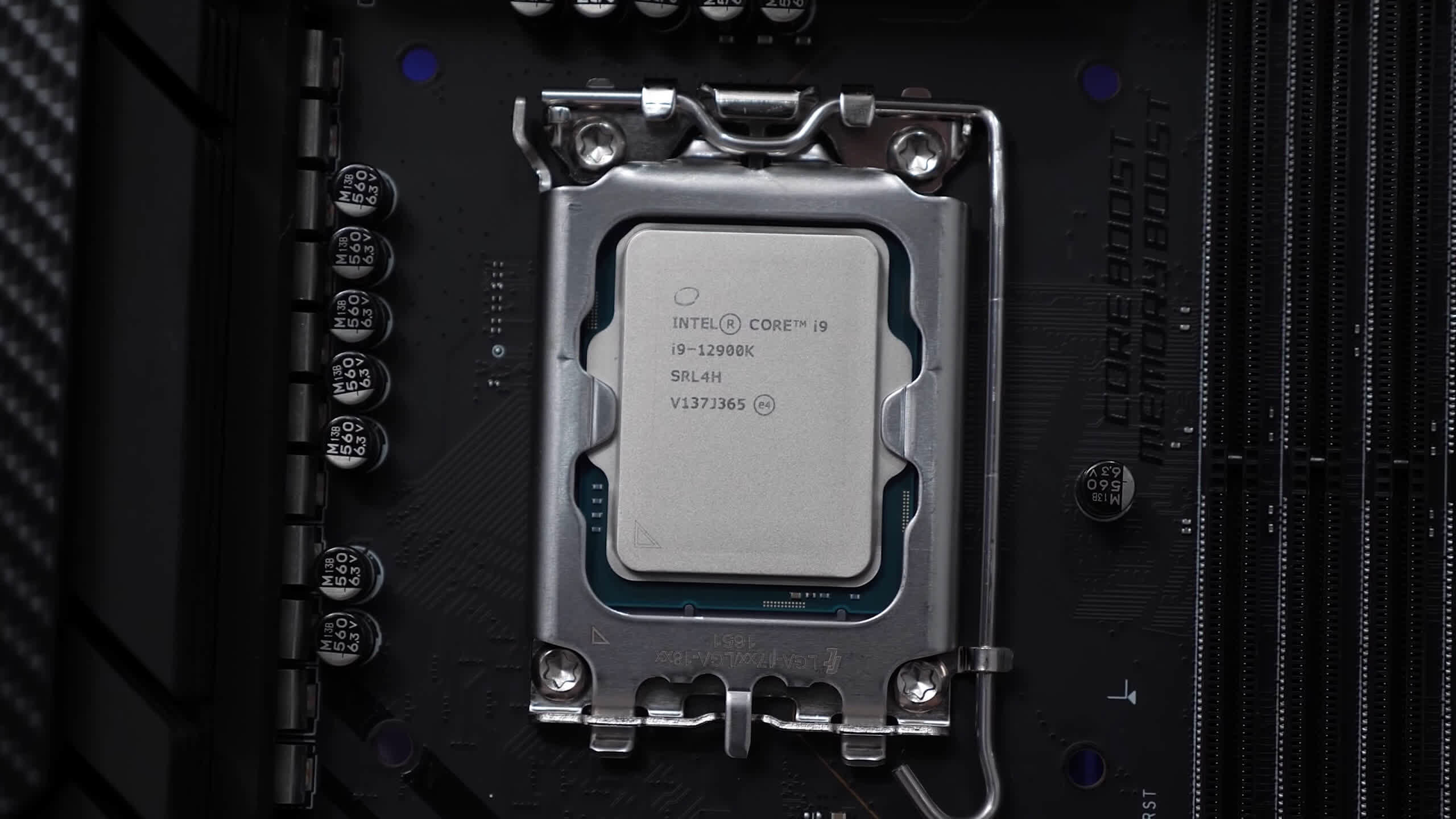
Then when it comes to gambling, the 12900K still shines because non a single game requires more than 8 Alder tree Lakes P-cores. Justified if a game can spread the freight across 16 cores, that won't be an issue. Even in the case of the 12600K, its cores are more strong enough to deal with the burden. If they couldn't, the game would solely glucinium playable using a in high spirits-remnant Processor like the 12900K or 5950X, and that's not going to find this decennium.
Now obviously, you'd ne'er run a 12th-gen CPU with just the E-cores, but at that place leave be a point eventually when you'll have to call on the E-cores for play and this could reduce performance by 20% operating room more, at least based on what we've seen hither. But again I don't expect that time will seminal fluid within the earthy lifespan of this series.
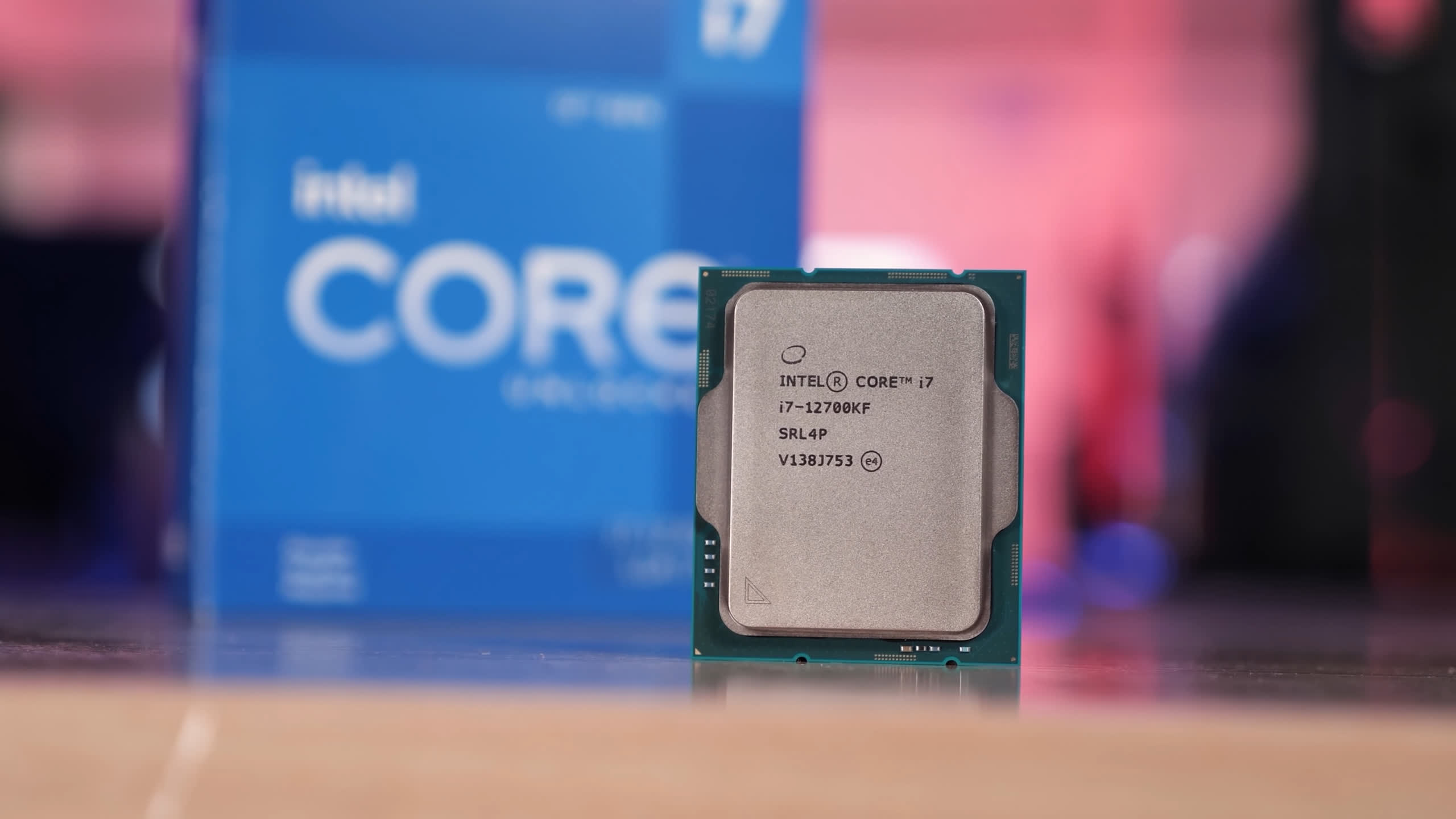
Another reason why E-cores take up for gamers is the compatibility issue with DRM, and I ran into that with this benchmark test. Previously I'd tested each CPU architectures using Watch Dogs Legion and Assassin's Creed Walhalla, but both games failed for this examination. Watch Dogs Legion worked with fair E-cores, or just P-cores, but the ruffle crashed the game which is strange As stock the 12th-gen CPUs work just fine. Then Assassin's Creed Valhalla failed to load due to the DRM detection issue with the hybrid 12th-gen architecture.
In short, the E-cores are a mistake for gaming, and if called upon they will slim down draw up rates. So for gamers the 12900K and 12700K are 8-core/16-thread CPUs and nothing more. The E-cores might atomic number 4 able to help with screen backgroun tasks, merely frankly on the background they'd be better stolen aid of by two more P-cores. In that respect is no argument gamers can cause for the existence of E-cores, you'd always be much fortunate replacing them with two additive P-cores.
Shopping Shortcuts:
- Intel Core i7-12700KF on Amazon
- Intel Core i7-12700K on Amazon
- Intel Core i9-12900K along Virago
- Intel Core i5-12600K on Amazon
- AMD Ryzen 5 5600X happening Amazon
- AMD Ryzen 9 5950X on Virago
- AMD Ryzen 7 5800X on Amazon
Source: https://www.techspot.com/review/2374-intel-alder-lake-architecture/
Posted by: wilsongeody1976.blogspot.com


0 Response to "Intel 12th-Gen Core Alder Lake Architectural Benchmark - wilsongeody1976"
Post a Comment